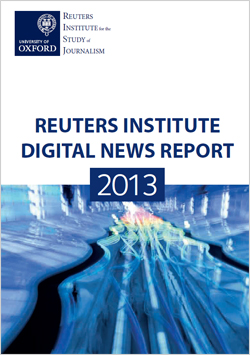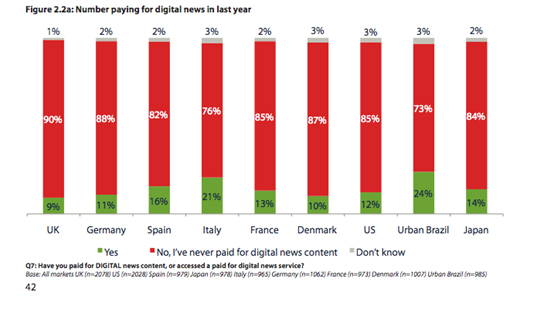3 findings to sit up and notice in the Reuters Digital News report…
Posted by Dr Jenny Kidd
 Today sees the publication of Reuters’ 2013 report into digital news trends. The 108 page report can be accessed online, and for the first time, the raw data are available for public use and re-skinning at www.digitalnewsreport.org.
Today sees the publication of Reuters’ 2013 report into digital news trends. The 108 page report can be accessed online, and for the first time, the raw data are available for public use and re-skinning at www.digitalnewsreport.org.
In quick summation, the report indicates a strong continued public demand for news in all 7 of the countries in the sample, which is, if anything, rising due to the increased use of mobile media devices. This is reassuring indeed – even if it does mask a slight bias toward men over the age of 35 accessing news via their smartphones. In the case of the UK however, we might note that the picture is slightly more worrisome, with respondents demonstrating the greatest propensity in the sample to be ‘not at all’ or ‘not very’ interested in news. Indeed, 9% in the UK excluded themselves from the survey on the grounds that they were simply ‘non-users’ of news (an indicative 4.5m people).
Beyond these macro-level findings there are three trends shaping the digital news landscape that I wish to highlight here. They are not earth-shattering realisations – nor are they even unexpected – but they demonstrate well the complexities and schisms in our changing media ecology.
1. Digital news is ubiquitous, pervasive, transmedial
The report provides sound evidence that our consumption of news is becoming fractured in space; that news narratives are now accessed from multiple entry points and platforms. This is especially the case now that tablets and smartphones emerge as real players in the digital news landscape; their use as news portals having doubled in the last year in most countries in the sample. Many respondents profess to be using two or more digital devices to access the news daily, and the use of smartphones and tablets with retina displays and multimedia capacity is encouraging an increased appetite for live news and video content on the move.
As such, a news item might best be described as transmedial and pervasive, indeed, never actually an ‘item’ at all. Instead, it is co-located, and embedded in existent narratives and frameworks of interpretation. As such, our experience of a news story can be partial, immersive, dislocated and perhaps above all else, social, even at the same time as most news consumption and sharing still happens in the home. Temporally, access is also shifting, with fewer people now following the traditional daily peaks in news consumption – traditionally breakfast and early evening. This is especially true of younger respondents in the sample.
It’s fair to say however that audiences do not seek out news in the digital landscape with such fragmented and extended consumption in mind…
2. Digital news access is not promiscuous
One finding that may seem surprising is the extent to which respondents value and seek out traditional news organisations within this new landscape. Aggregators (with the exception of Japan and to some extent the US) prove far less popular than established news brands. Respondents’ sources of news are thus far from casual and random, even in the digital environment. Trust and authority are markers of legitimacy of great value to respondents in the vast majority of cases (although less so for casual news users).
The picture is perhaps more complex even than is evident in the report when it comes to social media spaces. Social networks and blogs are seen as being regular sources of news for around 30% of respondents (a not insignificant number), but such sites might also be heavily populated by traditional media sources also, whether or not they are attributed or recognised as such.
The report concludes that there is ‘no evidence that brands are being substituted’ in the digital space. This seems to be especially true in the case of political news where, here in the UK at least, 72% of respondents turned to broadcasters and 52% turned to national newspapers for their news (whether online or offline).
All of that said, there is yet to emerge a consensus (assuming such a thing is desirable) about how traditional, and other, brands might fund their digital news endeavours. Respondents on the whole remain unwilling to pay for digital news as is soberingly demonstrated in the graph below:
Those who are willing to pay tend to be those who are either, firstly, tablet or smartphone owners, or, secondly, news lovers. Either way, they remain minorities.
For those who do pay for digital news, there are geographical distinctions at play in how this is best facilitated. Some constituents seemingly prefer one-off payments such as downloading apps (in France, Italy, Germany and Spain), and some prefer subscription services (in the US and Denmark in particular), with others split broadly down the middle (including the UK, Japan and Urban Brazil). Downloading an app or subscribing to a service of course again reaffirms the importance of trusted news sources and brand confidence.
That said, a detailed look at the specific case of under-45s demonstrates some significant and potentially seismic shifts are to come…
3. To under-45s, news itself is innately digital, malleable, spreadable.
One of the starkest observations to emerge from the report is that younger people in the sample – defined as under-45s – are inhabiting and carving out a very different news media landscape than those who are over 45. The report reveals the nuances of how that (admittedly broad) demographic sources and values news in the online landscape and what emerges is that news is now inseparable from digitality; it is natively digital. It is originated, produced, distributed, oriented, experienced, shared and critiqued within that landscape.
We might note a few trends that are incongruent with those for the wider sample: that 25-34 year olds are the most willing to pay for digital news across the whole sample and across all countries; that accessing news through social networks is seen as more fruitful and desirable than ‘search’; that in these environments sites and sources do maintain a level of anonymity (raising questions about how news ‘brand’ operates at the level of the social). This increasing sociality of news consumption gives us food for thought, raising – not for the first time – the prospect of an increasingly news-savvy youth; commenting, creating, sharing, representing, appropriating, questioning.
We start to see in the closing pages of the report an acknowledgement that the (transmediated) digital news event is becoming a participatory one also. This is likely to become ever more so part of the story a report such as this tells, giving insight into how this demographic in particular value the creative potentials of digital media in relation to news; the extent to which they consider themselves to be a part of the processes of news media ‘making’, and indeed, on occasion, its ‘un-making’.

